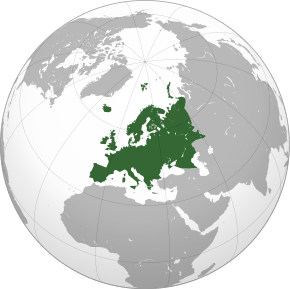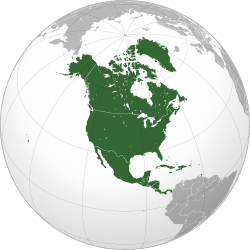Arctica
Arctica or Arctida[1] was an ancient continent which formed approximately 2.565 billion years ago in the Neoarchean era. It was made of Archaean cratons, including the Siberian Craton, with its Anabar/Aldan shields in Siberia,[2] and the Slave, Wyoming, Superior, and North Atlantic cratons in North America.[3] Arctica was named by Rogers 1996 because the Arctic Ocean formed by the separation of the North American and Siberian cratons.[4] Russian geologists writing in English call the continent "Arctida" since it was given that name in 1987,[1] alternatively the Hyperborean craton,[5] in reference to the hyperboreans in Greek mythology.
Nikolay Shatsky (Shatsky 1935) was the first to assume that the crust in the Arctic region was of continental origin.[6] Shatsky, however, was a "fixist" and, erroneously, explained the presence of Precambrian and Paleozoic metamorphic rocks on the New Siberian, Wrangel, and De long Islands with subduction. "Mobilists", on the other hand, also erroneously, proposed that North America had rifted from Eurasia and that the Arctic basins had opened behind a retreating Alaska.[7]
Precambrian continent
In his reconstruction of the supercontinent cycle, Rogers proposed that the continent Ur formed at about 3 Ga and formed East Gondwana in the Middle Proterozoic by accretion to East Antarctica; Arctica formed around 2.5–2 Ga by the amalgamation of the Canadian and Siberian shields plus Greenland; and Atlantica formed around 2 Ga by the amalgamation of the West African Craton and eastern South America. Arctica then grew around 1.5 Ga by accretion of East Antarctica and Baltica to form the supercontinent Nena. Around 1 Ga Nena, Ur, and Atlantica collided to form the supercontinent Rodinia.[8]
Rogers & Santosh 2003 argued that most cratons that were around at 2.5 Ga most likely formed in a single region simply because they were located in a single region in Pangaea, which is the reason Rogers argued for the existence of Arctica. The core of Arctica was the Canadian Shield, which Williams et al. 1991 named Kenorland. They argued that this continent formed around 2.5 Ga then rifted before reassembling along the 1.8 Ga Trans-Hudson and Taltson-Thelon orogenies. These two orogenies are derived from continental crust (not oceanic crust) and were probably intracontinental, leaving Kenorland intact from 2.5 Ga to present. Correlations between orogenies in Canada and Siberia remain more controversial.[9]
Laurentia and Baltica were connected during the Late Palaeoproterzoic (1.7–1.74 Ga) and Siberia later joined them. Paleomagnetic reconstructions indicate that they formed a single supercontinent during the Mesoproterozoic (1.5–1.45 Ga) but paleomagnetic data and geological evidences also suggest a considerable spatial gap between Siberia and Laurentia and Arctica is thought to be the missing link.[10]
Phanerozoic microcontinent
The current geological structure of the Arctic Region is the result of tectonic processes during the Mesozoic and Cenozoic (250 Ma to present) when the Amerasian and Eurasian basins formed, but the presence of Precambrian metamorphic complexes discovered in the 1980s indicated a continent once existed between Laurentia, Baltica, and Siberia.[11]
In the reconstruction of Metelkin, Vernikovsky & Matushkin 2015, Arctica originally formed as a continent during the Tonian 950 Ma and became part of the supercontinent Rodinia. It reformed during the Permian-Triassic 255 Ma and became part of Pangaea. During this period the configuration of Arctica changed and the continent moved from near the Equator to near the North Pole while keeping its position between three major cratons: Laurentia, Baltica, and Siberia.[1][12] An extended magmatic event, the High Arctic Large Igneous Province, broke Arctica in part 130–90 Ma, opened the Arctic Ocean, and left radiating dyke swarms across the Arctic.[13]
Fragments of this continent include the Kara Shelf, New Siberian Islands, northern Alaska, Chukotka Peninsula, Inuit Fold Belt in northern Greenland, and two Arctic underwater ridges, the Lomonosov and Alpha-Mendeleev Ridges. More recent reconstructions also include Barentsia (including Svalbard and Timan-Pechora Plates).[11] Remains of the last continent are now located on the Kara Sea Shelf, New Siberian Islands and adjacent shelf, Alaska north of Brooks Ridge, Chukchi Peninsula in eastern-most Siberia, and fragments in northern Greenland and Northern Canada and in the submerged Lomonosov Ridge.[14]
See also
- Arctic Alaska-Chukotka terrane – A terrane that includes parts of Alaska, Siberia and the continental shelf between them
- List of supercontinents – A list of the past, present, and speculative future supercontinents of Earth
- Penokean orogeny
- Timanide Orogen
References
Notes
- Vernikovsky & Dobretsov 2015, p. 206
- Siberian craton - a fragment of a Paleoproterozoic supercontinent
- Rogers 1996, Fig. 4, p. 97
- Rogers 1996, p. 97
- E.g. Khain, Polyakova & Filatova 2009, Tectonic units and their history, p. 335
- Khain & Filatova 2009, p. 1076
- Zonenshain & Natapov 1987, Introduction, p. 829
- Rogers 1996, Abstract
- Rogers & Santosh 2003, Arctica and Kenorland (~2500 Ma), pp. 360–361
- Tait & Pisarevsky 2009, p. 37
- Vernikovsky et al. 2014, Introduction, pp. 265–266
- Vernikovsky & Dobretsov 2015, Fig. 2, p. 208
- Ernst & Bleeker 2010, 90–130 Ma: northern Canada, initiation of the Arctic Ocean, p. 701, fig. 6b, p.705
- Metelkin, Vernikovsky & Matushkin 2015, Introduction, p. 114; Fig. 1, p. 115
Sources
- Ernst, R.; Bleeker, W. (2010). "Large igneous provinces (LIPs), giant dyke swarms, and mantle plumes: significance for breakup events within Canada and adjacent regions from 2.5 Ga to the Present". Canadian Journal of Earth Sciences. 47 (5): 695–739. Bibcode:2010CaJES..47..695E. doi:10.1139/E10-025. Retrieved 28 March 2016.CS1 maint: ref=harv (link)
- Khain, V. E.; Filatova, N. I. (2009). "From Hyperborea to Arctida: The Problem of the Precambrian Central Arctic Craton". Doklady Earth Sciences. 428 (1): 1076–1079. Bibcode:2009DokES.428.1076K. doi:10.1134/S1028334X09070071.CS1 maint: ref=harv (link)
- Khain, V. E.; Polyakova, I. D.; Filatova, N. I. (2009). "Tectonics and petroleum potential of the East Arctic province" (PDF). Russian Geology and Geophysics. 50 (4): 334–345. Bibcode:2009RuGG...50..334K. doi:10.1016/j.rgg.2009.03.006. Retrieved 5 March 2016.CS1 maint: ref=harv (link)
- Metelkin, D. V.; Vernikovsky, V. A.; Matushkin, N. Y. (2015). "Arctida between Rodinia and Pangea" (PDF). Precambrian Research. 259: 114–129. Bibcode:2015PreR..259..114M. doi:10.1016/j.precamres.2014.09.013. Retrieved 5 March 2016.CS1 maint: ref=harv (link)
- Rogers, J. J. W. (1996). "A history of continents in the past three billion years". Journal of Geology. 104: 91–107, Chicago. Bibcode:1996JG....104...91R. doi:10.1086/629803. JSTOR 30068065.CS1 maint: ref=harv (link)
- Rogers, J. J. W.; Santosh, M. (2003). "Supercontinents in Earth History" (PDF). Gondwana Research. 6 (3): 357–368. Bibcode:2003GondR...6..357R. doi:10.1016/S1342-937X(05)70993-X. Retrieved 8 March 2016.CS1 maint: ref=harv (link)
- Sankaran, A. V. (2003). "The Supercontinent Medley: Recent Views" (PDF). Current Science. 85 (8): 1121–1123. Retrieved 28 February 2016.CS1 maint: ref=harv (link)
- Shatsky, N. S. (1935). "On the tectonics of the Arctic". Geology and Mineral Resources in the North of the USSR (in Russian). 1. pp. 149–165.CS1 maint: ref=harv (link)
- Tait, J. A.; Pisarevsky, S. A. (2009). Siberia, Laurentia and Baltica in Mesoproterozoic (PDF). 2nd International Conference on Precambrian Continental Growth and Tectonism. doi:10.13140/2.1.3432.3840. Retrieved 19 March 2016.CS1 maint: ref=harv (link)
- Vernikovsky, V. A.; Dobretsov, N. L. (2015). "Geodynamic evolution of the Arctic Ocean and modern problems in geological studies of the Arctic region" (PDF). Herald of the Russian Academy of Sciences. 85 (3): 206–212. doi:10.1134/S1019331615030193. Retrieved 5 March 2016.CS1 maint: ref=harv (link)
- Vernikovsky, V. A.; Metelkin, D. V.; Vernikovskaya, A. E.; Matushkin, N. Y.; Lobkovsky, L. I.; Shipilov, E. V. (2014). "Early evolution stages of the arctic margins (Neoproterozoic-Paleozoic) and plate reconstructions" (PDF). Proceedings of the International Conference on Arctic Margins VI. Fairbanks, Alaska. Retrieved 19 March 2016.CS1 maint: ref=harv (link)
- Williams, H.; Hoffman, P. E.; Lewry, J. F.; Monger, J .W. H.; Rivers, T. (1991). "Anatomy of North America: thematic portrayals of the continent". Tectonophysics. 187 (1–3): 117–134. Bibcode:1991Tectp.187..117W. doi:10.1016/0040-1951(91)90416-P.CS1 maint: ref=harv (link)
- Zonenshain, L. P.; Natapov, L. M. (1987). "Tectonic History of the Arctic Region from the Ordivician Through the Cretaceous". In Herman, Yvonne (ed.). The Arctic Seas: Climatology, Oceanography, Geology, and Biology. Springer. ISBN 9781461306771. Retrieved 19 March 2016.CS1 maint: ref=harv (link)
.svg.png)
.svg.png)
.svg.png)
.svg.png)


.svg.png)
_political.svg.png)
.svg.png)
.svg.png)
.svg.png)